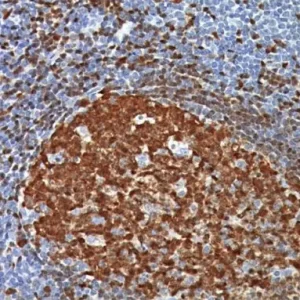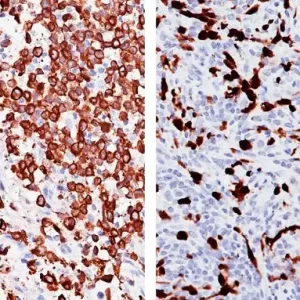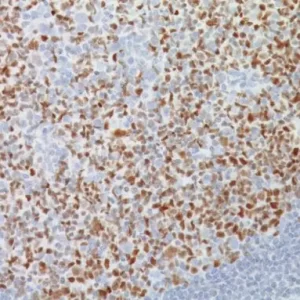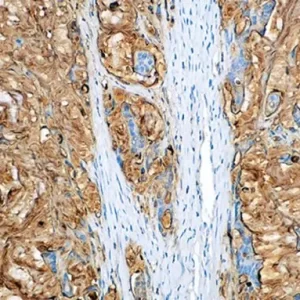Description
CD10, also known as common acute lymphoblastic leukemia (CALLA), has been shown to react with B and T lymphoblastic leukemia/lymphoma, follicular lymphoma, Burkitt’s lymphoma, and diffuse large B-cell lymphoma (1-3). CD10 has also been a very important marker in a panel, including CD20, CD5, CD23, cyclin D1, SOX11, BCL6 among others, to differentiate between small lymphoid cell lymphomas such as mantle cell lymphoma, follicular lymphoma, marginal zone lymphoma and small lymphocytic lymphoma (1-3). Studies have also shown that CD10 marks normal early lymphoid progenitors, immature B-cells in bone marrow, and germinal center cells in normal tonsil. It is also expressed in some non-lymphoid tissues such as fibroblasts, breast myoepithelium, and brush border and distal tubules of the kidney (1-3). CD10 has been shown to be expressed in clear cell renal cell carcinomas and may be a useful marker pointing to a renal source of carcinomas (4).
SPECIFICATIONS
Specifications
| INTENDED USE | IVD |
|---|---|
| SPECIES REACTIVITY | Human; others not tested |
| SOURCE | Mouse Monoclonal |
| CLONE | UMAB236 |
| ISOTYPE | IgG1 |
| ANTIGEN | Human recombinant protein of CD10 |
| POSITIVE CONTROL | Normal kidney and tonsil |
| BY LETTER | C |
DATASHEETS & SDS
REFERENCES
1. Kurtin PJ, et al. Demonstration of distinct antigenic profiles of small B-cell lymphomas by paraffin section immunohistochemistry. Am J Clin
Pathol. 1999;112:319-29.
2. de Leon ED, et al. Usefulness of an immunohistochemical panel in paraffin-embedded tissues for the differentiation of B-cell nonHodgkin’s lymphomas of small lymphocytes. Mod Pathol. 1998;11:1046-51.
3. de Boer CJ, et al. Bcl-1/cyclin D1 in malignant lymphoma. Ann Oncol. 1997;8 suppl 2:109-17.
4. Ortiz-Rey JA, et al. Expression of CD10 and renal cell carcinoma marker in clear cell renal cell carcinoma: analysis on tissue arrays. Actas Urol Esp. 2006 Mar;30(3):281-6.
5. Center for Disease Control Manual. Guide: Safety Management, NO. CDC-22, Atlanta, GA. April 30, 1976 “Decontamination of Laboratory Sink Drains to Remove Azide Salts.”
6. Clinical and Laboratory Standards Institute (CLSI). Protection of Laboratory Workers from Occupationally Acquired Infections; Approved Guideline-Fourth Edition CLSI document M29-A4 Wayne, PA 2014.







Reviews
There are no reviews yet.